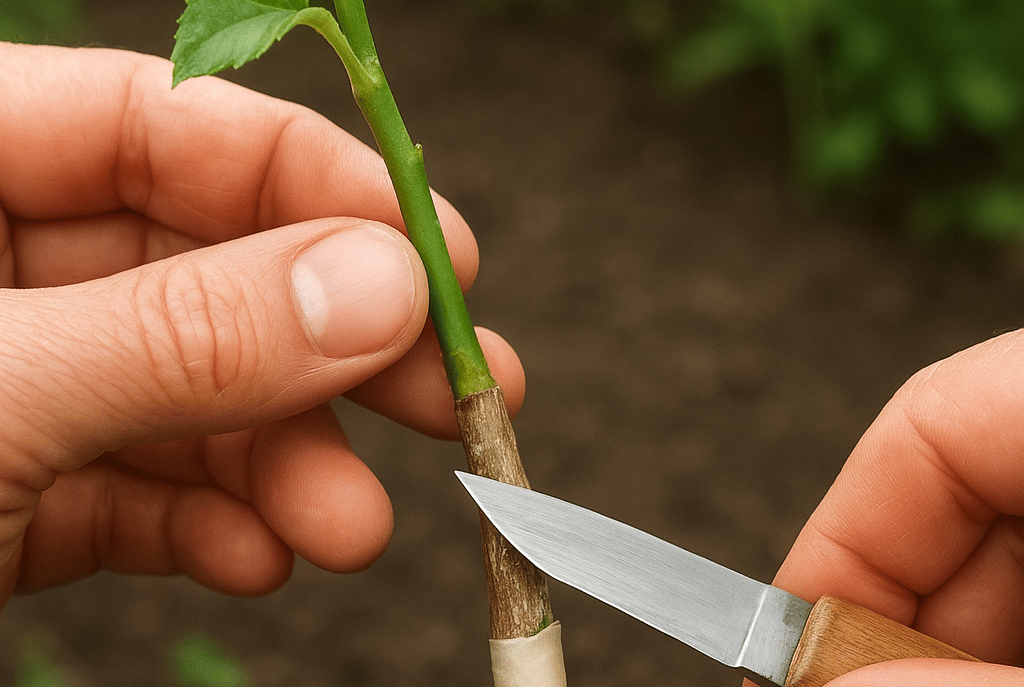🌿 GROWPlantWell – Nurture Nature, Transform Your Space 🌿
Grafting: The Art of Joining Plants for Better Growth
Learn how grafting works, its benefits, types, and step-by-step guide. Discover tips for successful grafting in fruit trees, ornamentals, and roses.
Grow Plant Well
8/15/20253 min read


🌿 Introduction
Grafting is a centuries-old horticultural technique where two plants are joined together to grow as one. It’s a popular method for propagating fruit trees 🍎, ornamental plants 🌸, and roses 🌹. By combining the strengths of two plants, grafting can improve growth, disease resistance, and fruit quality — and even save rare varieties from extinction.
❓ What is Grafting?
Grafting involves joining a scion (the upper part of the plant with desired traits) to a rootstock (the lower part that provides the root system). Once fused, they share nutrients and water, growing as a single plant.
🌟 Benefits of Grafting
🍏 Faster Fruit Production: Grafted plants mature and produce fruit earlier than seedlings.
🛡 Disease Resistance: Rootstocks can resist soil-borne pests and diseases.
🌳 Stronger Growth: Adapt plants to different soils and climates.
🎨 Variety on One Tree: Grow multiple fruit types on a single tree.
🪴 Clone Rare Varieties: Preserve heirloom or endangered plants.
🌱 Types of Grafting Techniques
1️⃣ Whip and Tongue Graft ✂️
Perfect for young plants with similar stem sizes. The cuts interlock for strong contact.
2️⃣ Cleft Graft 🌳
Used on older rootstocks to insert one or more scions. Common for rejuvenating trees.
3️⃣ Budding (T-Budding) 🌼
Inserts a single bud into a cut in the rootstock. Often used for roses and citrus trees.
4️⃣ Side Veneer Graft 🌲
Popular for evergreens and ornamentals; attaches scion to the side of the rootstock.
🛠 Step-by-Step Guide to Grafting
✂️ Choose Compatible Plants — Ensure the scion and rootstock are from closely related species.
🧼 Sanitise Tools — Clean blades to prevent disease.
🌳 Make the Cut — Use the chosen grafting technique for clean, matching cuts.
🔗 Join Scion and Rootstock — Align cambium layers for nutrient flow.
🩹 Secure the Graft — Use grafting tape or wax to protect from moisture loss.
💧 Care After Grafting — Keep the plant in a sheltered, humid environment until healing occurs.
⚠️ Common Mistakes to Avoid
❌ Poor alignment of cambium layers.
❌ Using diseased or unhealthy plant material.
❌ Grafting in extreme temperatures.
❌ Allowing the graft to dry out before healing.
🕒 Best Time for Grafting
Fruit Trees: Late winter to early spring before buds open.
Roses: Late spring to summer during active growth.
Evergreens: Late summer for strong healing before dormancy.
💡 Pro Tips for Success
Always use sharp, sterilised tools.
Keep grafts moist and shaded until they take.
Label grafts with the variety and date for record-keeping.
Practice on inexpensive plants before working on valuable specimens.
🌸 Final Thoughts
Grafting is both an art and a science. With the right technique, patience, and care, you can create stronger, more productive plants and preserve rare varieties for future generations. Whether you’re adding a new apple variety to your tree 🍏 or crafting a rose with unique blooms 🌹, grafting opens up endless gardening possibilities.
🌱 Grafting Q&A – Everything You Need to Know
❓ What is grafting in plants?
Grafting is a horticultural technique where tissues from two plants are joined so they grow as one. The top part (scion) is fused onto the root system (rootstock) to combine desirable traits like disease resistance and high yield.
❓ Why is grafting important in gardening and farming?
Grafting improves plant quality, increases disease resistance, boosts fruit production, and allows the combination of traits from different plants.
❓ Which plants are best for grafting?
Commonly grafted plants include 🍎 apples, 🍐 pears, 🍒 cherries, 🍇 grapes, 🌹 roses, and 🍋 citrus fruits.
❓ How long does grafting take to heal?
Healing time varies by plant and method but generally takes 2–8 weeks for a strong union to form.
❓ What are the main types of grafting?
✂️ Whip and Tongue Grafting – For small stems.
🌿 Cleft Grafting – For thicker rootstocks.
🌳 Budding – Inserting a single bud into rootstock.
🪴 Approach Grafting – Joining plants while both have roots.
❓ Can grafting be done at any time of year?
The best time is during dormant seasons (late winter or early spring) when plants are not actively growing.
❓ Is grafting better than growing from seeds?
For certain plants, yes — grafting ensures predictable traits and faster fruiting compared to seeds, which may produce variable results.